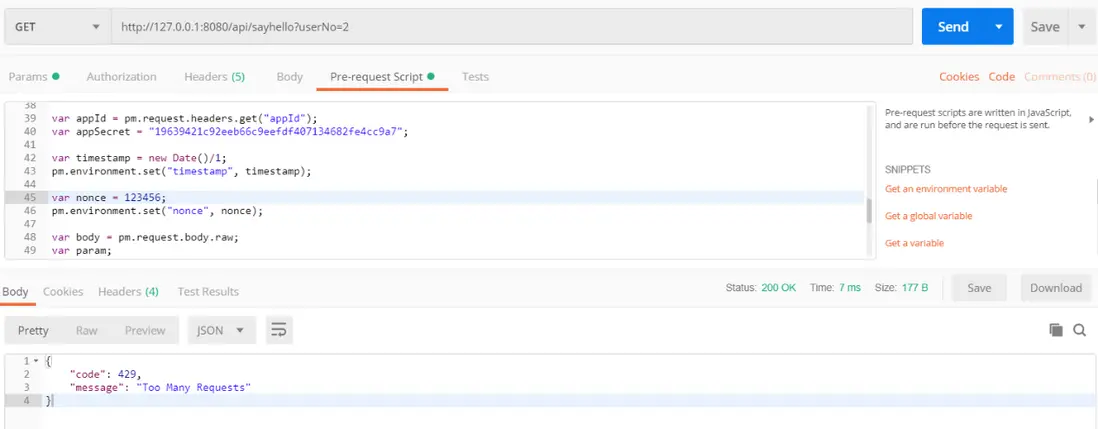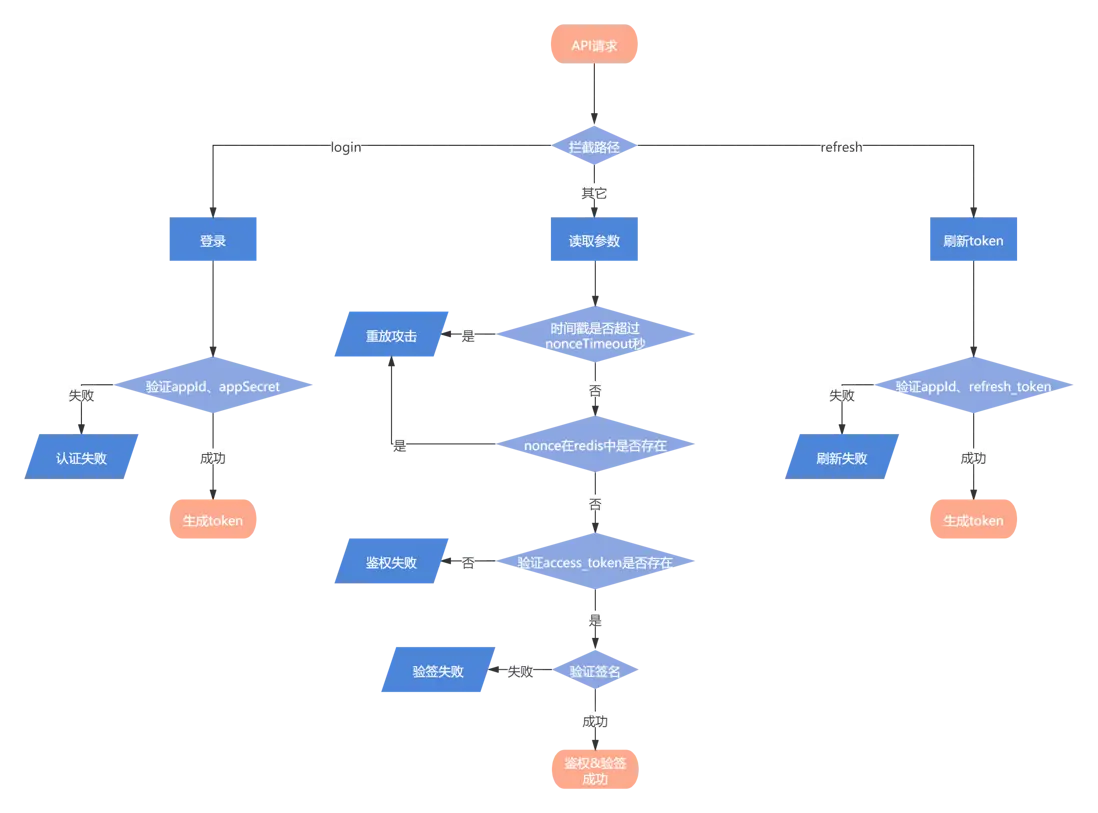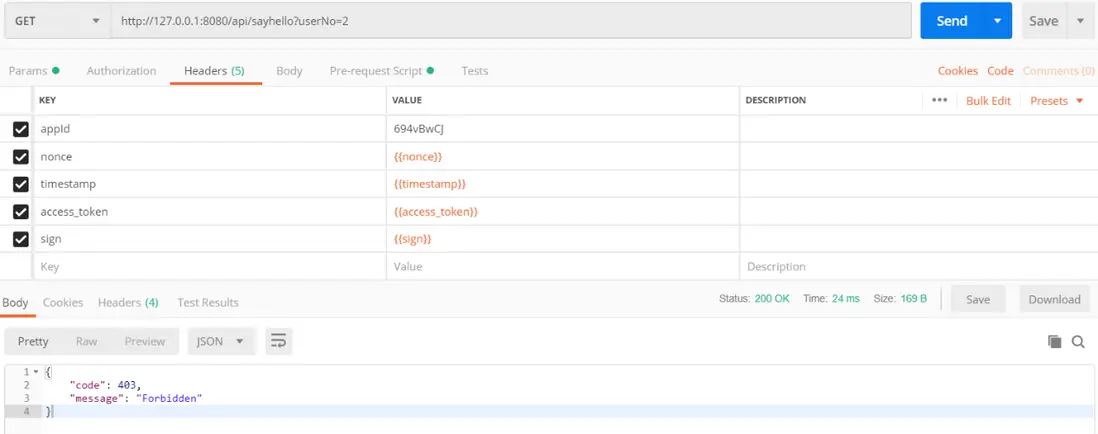背景
Leader:現在組內新建系統的API網關,你設計時要充分考慮接口的安全,防止被篡改和暴力攻擊。
Coder:好的,安全方面我們是有充分考慮的,通過驗籤防止入參被篡改,結合時間戳防止暴力攻擊。
知識儲備
基於Token的鑑權方式是無狀態的,服務端不再需要存儲Session信息,是分佈式系統的主要鑑權方案。
1、開發者認證
開發者認證也就是登錄校驗,網關校驗用户上送的appId和appSecret,如果跟redis中保存的一致,則生成access_token和refresh_token並返回給用户,用户暫存該token,訪問其它API接口時需要上送access_token。
2、API接口公共請求參數
| 參數 | 參數名 | 備註 |
|---|---|---|
| appId | 應用ID | 標識調用方的身份 |
| access_token | token | 示例是通過UUID生成 |
| sign | 簽名 | |
| timestamp | 時間戳 | 用於防禦重放攻擊 |
| nonce | 隨機數 | 用於防禦重放攻擊 |
3、重放攻擊
重放攻擊是指攻擊者發送目的主機已接收過的數據,以達到欺騙系統的目的,主要用於身份認證過程,破壞認證的正確性。
我們主要通過驗證時間戳和隨機數來防禦重放攻擊。
1)驗證timestamp
判斷時間戳timestamp是否超過nonceTimeout秒,超時則判別為重放攻擊。
2)驗證nonce
驗證隨機數nonce在redis中是否存在,如果存在,則判別為重放攻擊,否則將nonce記錄在redis中(示例中key的生成規則是:"NS"+appId+nonce),失效時間為nonceTimeout秒。
4、鑑權
驗證access_token在redis中是否存在,若已過期,則無權訪問API接口。用户可以刷新token,只要refresh_token在redis中存在,則網關重新生成access_token和refresh_token。通常refresh_token保存的時間較access_token久。
5、驗籤
1)將業務參數和timestamp、nonce、appid按鍵值對字典排序後通過&拼接,例如:appid=appid&key1=value1&key2=value2&nonce=random×atmp=1629777776799,得到stringA;
2)stringA再拼接appsecret,例如:stringA&appsecret=appsecret,得到stringB;
3)最後將stringB通過md5加密並轉大寫,即uppercase(md5(stringB)),得到簽名sign,跟用户請求API接口時上送的簽名對比,如果相同,則驗籤通過;也可以採用SHA256WithRSA簽名算法,調用方生成一對RSA公私鑰,調用方用私鑰加簽,服務方用公鑰驗籤。
實操
我們通過實現過濾器接口完成API接口鑑權驗籤動作。
過濾器是在請求進入Tomcat容器後,但請求進入servlet之前進行預處理的。請求結束返回也是在servlet處理完後,返回給前端之前。
進入servlet之前,主要是兩個參數:ServletRequest,ServletResponse,我們可以通過ServletRequest得到HttpServletRequest,此時就可以對web服務器管理的所有web資源:例如Jsp, Servlet, 靜態圖片文件或靜態html文件等進行攔截,從而實現一些特殊的功能。例如實現URL級別的權限訪問控制、過濾敏感詞彙、壓縮響應信息、字符集統一等一些高級功能。它主要用於對用户請求進行預處理,也可以對HttpServletResponse進行後處理。使用Filter的完整流程:Filter對用户請求進行預處理,接着將請求交給Servlet進行處理並生成響應,最後Filter再對服務器響應進行後處理。它是隨你的web應用啓動而啓動的,只初始化一次,以後就可以攔截相關請求,只有當你的web應用停止或重新部署的時候才銷燬。(每次熱部署後,都會銷燬)。
@WebFilter(urlPatterns = "/api/*")
public class PreFilter implements Filter {
private static Logger logger = Logger.getLogger("PreFilter");
private Long nonceTimeout = 300l;
@Autowired
private StringRedisTemplate stringRedisTemplate;
@Override
public void doFilter(ServletRequest servletRequest, ServletResponse servletResponse, FilterChain filterChain) throws IOException, ServletException {
logger.info("進入過濾器處理");
HttpServletRequest request = (HttpServletRequest) servletRequest;
RedisUtil redisUtil = new RedisUtil(stringRedisTemplate);
ServletOutputStream out = servletResponse.getOutputStream();
String outString = null;
try {
String appId = request.getHeader("appId");
String accessToken = request.getHeader("access_token");
String sign = request.getHeader("sign");
String timestamp = request.getHeader("timestamp");
String nonce = request.getHeader("nonce");
Map<String, String> paramMap = new HashMap<>();
InputStream in = request.getInputStream();
String body = StreamUtils.copyToString(in, Charset.forName("UTF-8"));
/*
參數來自請求body
*/
JSONObject json = JSONObject.parseObject(body);
if (json != null && !json.isEmpty()) {
logger.info("body = " + json);
for (String key : json.keySet()) {
paramMap.put(key, json.getString(key));
}
}
/*
參數來自請求url的QueryString
*/
String query = request.getQueryString();
if (query != null) {
logger.info("queryString = " + URLDecoder.decode(query, "UTF-8"));
String[] arr = query.split("&");
for (String pair : arr) {
String[] ele = pair.split("=");
if (ele.length == 2) {
paramMap.put(ele[0], ele[1]);
}
}
}
paramMap.put("appid", appId);
paramMap.put("timestamp", timestamp);
paramMap.put("nonce", nonce);
String stringA = AuthUtil.concatParam(paramMap);
Long now = System.currentTimeMillis();
/*
判斷時間戳是否超過nonceTimeout秒,超時則判別為重放功擊
*/
if (timestamp != null && (now - Long.parseLong(timestamp) < nonceTimeout * 1000)) {
/*
驗證nonce在redis中是否存在,如果存在,則判別為重放功擊,否則將nonce記錄在redis中(key為:"NS"+appId+nonce),失效時間為nonceTimeout秒
*/
if (redisUtil.exists("NS" + appId + nonce)) {
outString = String.format("{\"code\": 429, \"message\": \"Too Many Requests\"}");
out.write(outString.getBytes());
out.flush();
} else {
redisUtil.set("NS" + appId + nonce, nonce, nonceTimeout);
/*
驗證access_token是否存在
*/
if (redisUtil.exists(accessToken) && redisUtil.exists(appId)) {
String redis_appid = (String) redisUtil.get(accessToken);
String redis_appsecret = (String) redisUtil.get(redis_appid);
String _sign = AuthUtil.getSign(stringA, redis_appsecret);
/*
驗證簽名是否通過,若通過,則開發者認證也會驗證通過
*/
if (_sign.equals(sign)) {
filterChain.doFilter(servletRequest, servletResponse);
} else {
outString = String.format("{\"code\": 403, \"message\": \"Forbidden\"}");
out.write(outString.getBytes());
out.flush();
}
} else {
outString = String.format("{\"code\": 401, \"message\": \"Unauthorized\"}");
out.write(outString.getBytes());
out.flush();
}
}
} else {
outString = String.format("{\"code\": 400, \"message\": \"Bad Request\"}");
out.write(outString.getBytes());
out.flush();
}
} catch (Exception e) {
e.printStackTrace();
outString = String.format("{\"code\": 500, \"message\": \"Internal Server Error\"}");
out.write(outString.getBytes());
out.flush();
}
}
}需要引入以下依賴:
<dependency>
<groupId>org.springframework.boot</groupId>
<artifactId>spring-boot-starter-data-redis</artifactId>
</dependency>
<dependency>
<groupId>commons-codec</groupId>
<artifactId>commons-codec</artifactId>
</dependency> 調用登錄接口獲取token後,再調用 http://127.0.0.1:8080/api/sayhello?userNo=2,返回結果正常。

待token失效後,再請求 http://127.0.0.1:8080/api/sayhello?userNo=2,返回結果是未授權。

在Postman的Pre-request Script中將nonce寫死為123456,首次請求成功,再次請求則報錯“Too Many Requests”,即多次nonce送值相同時,識別出重放攻擊。

在Postman的Pre-request Script中將簽名sign的值變更,請求報錯“Forbidden”,即驗證簽名不通過。













